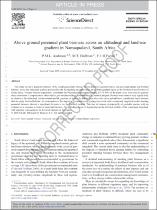 ResearchSpace
ResearchSpace
Above ground perennial plant biomass across an altitudinal and land-use gradient in Namaqualand, South Africa
JavaScript is disabled for your browser. Some features of this site may not work without it.
- ResearchSpace
- →
- Research Publications/Outputs
- →
- Journal Articles
- →
- View Item
| dc.contributor.author |
Anderson, PML

|
|
| dc.contributor.author |
Hoffman, MT

|
|
| dc.contributor.author |
O'Farrell, Patrick J

|
|
| dc.date.accessioned | 2010-12-20T11:20:49Z | |
| dc.date.available | 2010-12-20T11:20:49Z | |
| dc.date.issued | 2010-08 | |
| dc.identifier.citation | Anderson, PML, Hoffman, MT and O'Farrell, PJ. 2010. Above ground perennial plant biomass across an altitudinal and land-use gradient in Namaqualand, South Africa. South African Journal of Botany, Vol. 76(3), pp 471-481 | en |
| dc.identifier.issn | 0254-6299 | |
| dc.identifier.uri | http://www.sciencedirect.com/science?_ob=MImg&_imagekey=B7XN9-4YX700D-1-F&_cdi=29693&_user=958262&_pii=S0254629910001171&_origin=search&_coverDate=08/31/2010&_sk=999239996&view=c&wchp=dGLbVlW-zSkzV&md5=4038d0fc44f930d99f26826ae3d5199d&ie=/sdarticle.pdf | |
| dc.identifier.uri | http://hdl.handle.net/10204/4685 | |
| dc.description | Copyright: Elsevier 2010. This is the post print version of the work. The definitive version is published in the South African Journal of Botany, Vol. 76(3), pp 471-481 | en |
| dc.description.abstract | This study set out to generate estimates of the standing perennial biomass for six different vegetation types, and associated upland and lowland habitats, across the altitudinal gradient presented by the Kamiesberg mountain range in the Namaqualand region of the Northern Cape Province of South Africa. Volume-biomass regressions, established for 94 perennial species accounting for 70–80% of the plant cover, were used to generate these estimations. Comparisons to other studies give similar findings, corroborating the method adopted. Biomass was found to vary significantly in relation to the altitudinal, and associated rainfall, gradient, as well as by habitat type where the rocky uplands have considerably more biomass that the sandy lowland habitats. An examination of the impact of sustained heavy grazing associated with a communal rangeland on this standing perennial biomass, showed a significant decrease in on the lowland habitats. This loss in biomass is principally of palatable species, with no evidence of a response in terms of perennial biomass. These findings point to degradation on the lowland habitats of the communal rangeland, with negative consequences for livestock farmers in the region. | en |
| dc.language.iso | en | en |
| dc.publisher | Elsevier | en |
| dc.relation.ispartofseries | Journal Article | en |
| dc.subject | Above ground biomass | en |
| dc.subject | Communal land use | en |
| dc.subject | Grazing impacts | en |
| dc.subject | Volume biomass regressions | en |
| dc.subject | Botany | en |
| dc.title | Above ground perennial plant biomass across an altitudinal and land-use gradient in Namaqualand, South Africa | en |
| dc.type | Article | en |
| dc.identifier.apacitation | Anderson, P., Hoffman, M., & O'Farrell, P. J. (2010). Above ground perennial plant biomass across an altitudinal and land-use gradient in Namaqualand, South Africa. http://hdl.handle.net/10204/4685 | en_ZA |
| dc.identifier.chicagocitation | Anderson, PML, MT Hoffman, and Patrick J O'Farrell "Above ground perennial plant biomass across an altitudinal and land-use gradient in Namaqualand, South Africa." (2010) http://hdl.handle.net/10204/4685 | en_ZA |
| dc.identifier.vancouvercitation | Anderson P, Hoffman M, O'Farrell PJ. Above ground perennial plant biomass across an altitudinal and land-use gradient in Namaqualand, South Africa. 2010; http://hdl.handle.net/10204/4685. | en_ZA |
| dc.identifier.ris | TY - Article AU - Anderson, PML AU - Hoffman, MT AU - O'Farrell, Patrick J AB - This study set out to generate estimates of the standing perennial biomass for six different vegetation types, and associated upland and lowland habitats, across the altitudinal gradient presented by the Kamiesberg mountain range in the Namaqualand region of the Northern Cape Province of South Africa. Volume-biomass regressions, established for 94 perennial species accounting for 70–80% of the plant cover, were used to generate these estimations. Comparisons to other studies give similar findings, corroborating the method adopted. Biomass was found to vary significantly in relation to the altitudinal, and associated rainfall, gradient, as well as by habitat type where the rocky uplands have considerably more biomass that the sandy lowland habitats. An examination of the impact of sustained heavy grazing associated with a communal rangeland on this standing perennial biomass, showed a significant decrease in on the lowland habitats. This loss in biomass is principally of palatable species, with no evidence of a response in terms of perennial biomass. These findings point to degradation on the lowland habitats of the communal rangeland, with negative consequences for livestock farmers in the region. DA - 2010-08 DB - ResearchSpace DP - CSIR KW - Above ground biomass KW - Communal land use KW - Grazing impacts KW - Volume biomass regressions KW - Botany LK - https://researchspace.csir.co.za PY - 2010 SM - 0254-6299 T1 - Above ground perennial plant biomass across an altitudinal and land-use gradient in Namaqualand, South Africa TI - Above ground perennial plant biomass across an altitudinal and land-use gradient in Namaqualand, South Africa UR - http://hdl.handle.net/10204/4685 ER - | en_ZA |





